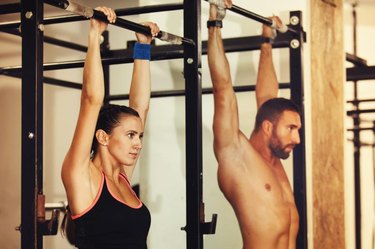
You do pull-ups to strengthen your shoulders, back and biceps, and yet, you end up feeling an ache in your abs. It's not just a good stretch or hard-earned fatigue -- you're experiencing outright pain in your stomach muscles.
Don't underestimate the role your abs play in pulling yourself up and over the bar. They stabilize your center, are the powerhouse from which all your other muscles get their strength and support your breathing. You could easily overwork them during a tough upper-body session and actually pull a muscle in your abs.
Video of the Day
Video of the Day
Warning
If the pain is sharp and severe or lower in your groin, see a doctor immediately. It could be a hernia or muscle tear that needs medical attention. Additionally, the pain in your abdomen might just coincidentally occur during your pull-up set, but indicate another serious liver or gall bladder condition.
Read More: Which Muscles Are Used During Pull-Ups?
Improper Breathing
You'll naturally experience an increase in abdominal pressure when doing a pull-up. That's why you should exhale when you exert during the pulling up phase of the exercise. Exhaling reduces the pressure.
Some people naturally hold their breath to get through a tough set. This only increases the amount of pressure in your abdomen and can lead to discomfort. Consciously use the breath as part of the exercise -- exhale as you pull-up, inhale as you get ready to go again.
No Kipping
Kipping is a move you'll see in some pull-ups, especially CrossFit-style versions. It's when you use a swing of your body -- basically, use momentum -- to get up and over the bar.
However, kipping requires a lot of extra movement from your legs, spine and abs. It's also a move that requires skill and proper technique. Without proper execution, the move primes you for shoulder, back and, possibly, abdominal injury.
If you're a competitive CrossFitter and want to master the move, seek out a quality coach. Otherwise, kipping pull-ups don't offer greater strength benefits when compared to standard pull-ups during which you keep your body still, so there's no need to take the risk.
Pulled Muscle
During a properly-executed pull-up, you brace your abdominals to support your spine. If you strain too much to fit in one more repetitions, it's possible to overexert these supporting muscles.
The pulled muscle will likely occur in the external obliques, a deep rotational and stabilizing muscle, which a study published in a 2010 issue of the Journal of Strength and Conditioning Research showed notably activates during several types of pull-ups. A pull may also occur in the rectus abdominis, the superficial front sheath of your abs.
When the muscle or muscles are pulled, your abs might feel tender to the touch, and could even ache when you breath or shift position.
Read More: Pulled Abdominal Muscle or a Hernia?
How to Do a Standard Pull-Up

A standard pull-up is less likely to result in abdominal pain. You may need help at first, either from an assisted pull-up machine or from a spotter who holds your legs and helps give you the momentum to get over the bar.
Step 1
Hold onto a pull-up bar with an overhand grip. Place you hands shoulder-distance apart.
Step 2
Allow your body to hang. Your arms should be fully extended. Bring your legs together and draw your abs in to create a stable body.
Step 3
Pull through your elbows to bring your collar bones up to the bar. Visualize your shoulder blades pulling together and down your back. Pause momentarily at the top and use control to lower back to a hang. Keep your abs and butt engaged the whole time to prevent swinging.